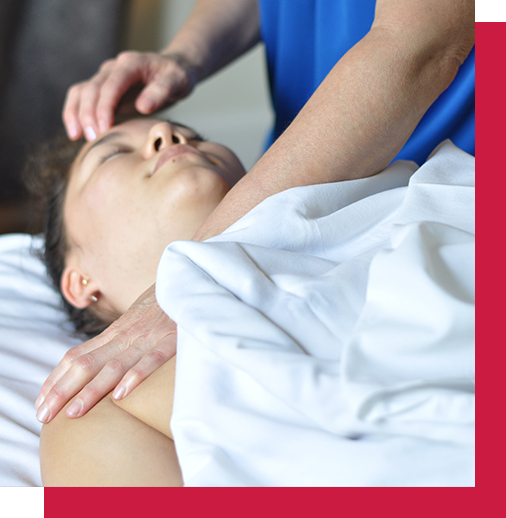CranioSacral Therapy (CST) was pioneered and developed by osteopathic physician John E. Upledger following extensive scientific studies from 1975 to 1983 at Michigan State University, where he served as a clinical researcher and Professor of Biomechanics.

What is Craniosacral Therapy?
CST is a gentle, hands-on method of evaluating and enhancing the functioning of a physiological body system called the craniosacral system – comprised of the membranes and cerebrospinal fluid that surround and protect the brain and spinal cord.
Using a soft touch generally no greater than 5 grams, or about the weight of a nickel, practitioners release restrictions in the craniosacral system to improve the functioning of the central nervous system.
By complementing the body’s natural healing processes, CST is increasingly used as a preventive health measure for its ability to bolster resistance to disease and is effective for a wide range of medical problems associated with pain and dysfunction.
What Is a Craniosacral Therapy Session Like?
For the hands-on work to be most effective, you should wear loose, thin clothing. This way, I can better sense what’s going on in your body. I’ll ask you to lie on your back on a massage table. By quietly resting your hands on your skull and sacrum, I will evaluate your craniosacral rhythms. This in itself can create a shift in energy. I will use the bones of the sacrum and cranium as “handles” to manipulate the deeper layers of fluid and membranes. No instruments or devices are used.
You and I will work closely together. You might feel a quieting down, sinking in, and deeper awareness. The whole idea is that I will work with such gentleness and subtleness that the body itself can do the healing and necessary adjustments. A session can be described as a physically connected meditation.
Healing then can occur via the corrective mechanism known as the still point, the spontaneous quiet between waves. Typically, you have one every three to four minutes, and it lasts from five to sixty seconds. It’s a natural pause in the rhythm. Synchronizing and optimizing the waves, still points are like sighs. During sessions, when you’re more sensitive to them, they’re like moments of deep relaxation in which you let go and return to yourself.
The Benefits of Craniosacral Therapy
CST has been used to treat a variety of conditions, both physical and psychological. The Upledger Institute lists the following disorders as suitable for treatment with CST:
- Alzheimer’s disease
- autism
- back pain
- brain injury
- central nervous system disorders
- chronic fatigue
- colic
- concussion
- dementia
- fibromyalgia
- immune disorders
- learning disabilities
- migraines
- neck pain
- post-traumatic stress disorder (PTSD)
- scoliosis
- spinal cord injury
- stress
According to the University of Minnesota, CST may benefit individuals by inspiring a change in their attitude to their health and wellbeing.
